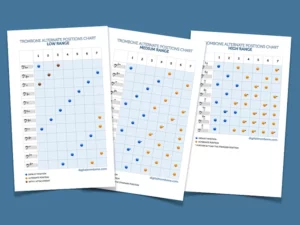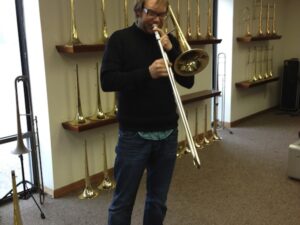
Trombone lesson: Altered scale in all keys
Did you read my previous article on trombone scale exercises? Then let’s move on with the same concept using the altered scale!
I use the altered scale a lot when I improvise. It has more edge and tensions than any mode of the major scale and is a god match for a large variety of chords.
Here’s an altered scale in the key of C:

It consists of the root, b9, #9, major third, #11, b6, and the b7. These are all notes you use in an altered dominant chord. As a matter of fact, you can play all the notes in the scale in one big fat chord, creating a C7 b9 b5 b13. Ask Thad (Jones) if this sounds good orchestrated for big band!
Note that the altered scale in C (or altered dominant scale, or Super Locrian scale) consists of the same notes as a jazz minor scale in Db.
The altered scale is actually very close to a standard major scale; put a flat in front of the C, and you get a Cb major scale.
Try improvising with the C altered scale over these chords (bold means an especially good match):
- C7alt
- Db-maj7
- Emaj7 #11
- Gb13#11
- Ab9 b13
- Bb-7b5 (Bbø)
The exercises below are simple and straight ahead, just get started and play and you’ll eventually “get it into your slide arm”. And as you go along you will probably discover that the scale fits the trombone quite well, also in some of the keys that usually aren’t that comfortable on the trombone.
If you have access to a keyboard (or piano) I recommend that you hit an altered chord with the sustain pedal while you play the scale in order to get the sound of it in a context. Dig in to each note in the scale, and get familiar with its specific sound and character. When you are familiar with the sound of the scale on top of an altered chord, try moving on to some other chords that the scale is suited for.
Find the time it takes to get this scale down, I promise that it´s worth it!
[nggallery id=20]
Get a printer-friendly version:
[wp_eStore_fancy1 id=4]
Do you like this exercise? Feel free to leave a comment or share it with your friends!
And don´t forget to claim your free jazz etude – sign up for the newsletter now!
5 Comments
-
Can you put a non altered one . I have honor band and really need to get the original ones down. I would love to make it to state . first year player and freshman !
-
Hey, I’ve been enjoying your posts for a while now, and thought I’d better “throw you a bone” and buy something… I tried downloading the altered scale worksheets (can’t believe I’ve WRITING these out for kids all these years!)…. anyhooo, the “add to cart” button seems to lead into Neverland. If you get that link up, the deal’s still on 🙂
Keep up the good work! Lotsa fun to read.
-
Hi paul,
Shop is about to be updated, not working perfect all the time. I do monitor all sales though 🙂
I see the purchase went through ok.
Thanks for the kind words!
-
Greetings,
I have been doodling since my teens (48 now). I learned how to do it before I ever heard about it – I somehow stumbled upon it in my improv efforts. It feels very natural /easy to me – so much so that I most likely do not actually practice it as much as I should – and its an important part of my playing.
On to my question…Do you experience any difficulty in the high range with doodling? Once I reach a G above the staff my ease at doodling suffers dramatically. I’ve never heard anyone else address this dilemma before and I wonder whether its just my issue and nobody else’s.
Thanks,
Steve -
Hi Steve,
My experience is that doodle does not get too affected when playing in the high range. My guess would be that you possibly change your embouchure when playing in a high range. Make sure to keep the distance between the corners of your mouth the same regardless of the register. I have seen many players smiling in the high range, and that is bad for both doodle and the high register in general.
Cheers,
Anders






